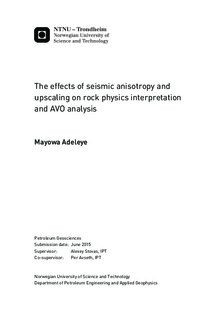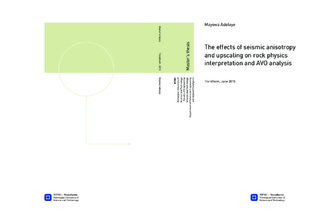| dc.description.abstract | In seismic reservior characterization, it is important that the measured sonic log used is accurate and consistent. Due to anisotropic effects in the reservoir, which is majorly caused as a results of interbedded sequence of sand and shales, sonic log (compressional and shear wave velocities) acquired in vertical wells are different from those acquired in deviated wells. Rock physics models are created for anisotropic heterogeneous sand-shale sequence. These models are varied as a function
of angle, porosity, saturation and net to gross. Variation of Thomsen anisotropic parameters and anelliptic parameters as a function of saturation and net-to-gross are investigated in order to understand the significant of anisotropy on these properties. From the rock physics modelling, anisotropic effect becomes more pronounced at high propagation angle and also the variation of the geologic parameters strongly depends on the propagation angle. Anisotropy effects decreases with increasing net-to-gross and anelliptic parameters are more sensitive to fluid saturation compared to Thomsen anisotropy parameters.
A method is proposed for anisotropy correction of deviated wells using core measurement (model rock properties) of sand and shale from the study area, the inclination angle of the well and the net to gross ratio of the reservoir. The anisotropy corrected logs are then used for improved rock physics interpretation using the rock physics templates(RPT) and AVO analysis. The proposed correction is lithology dependent and the correction is significant in regions with low net-to-gross. Discrimination of lithologies and fluid saturation on the rock physics template is enhanced as a result of the anisotropy correction.
The rock physics templates are constructed for different net to gross and propagation angles for varying fluid saturation in order to account for anisotropic effects. There is better separation of water sands and gas sand on the horizontal RPT(created at 72 deg) compared to vertical RPT(created at 0 deg). Vertical well, deviated well and anisotropy corrected well log data from the North Sea are
superimposed on the rock-physics templates. Poor separation of lithology and saturation is observed on the RPT using the deviated well. It can be observed that the anisotropy corrected deviated well follows similar trends as the vertical well. Anisotropy effect on the reservoir properties that are accounted for using the proposed method are clearly seen on 3D rock physics templates. AVO inversion is also performed on the horizon attribute data from study area. The inverted rock physics
properties are plotted on the created rock physics models for two vertical wells from the study area. The two vertical wells show different AVO class response. The net-to-gross and porosity are different for the two wells and in general, these observations are constrained by local geology. | |

